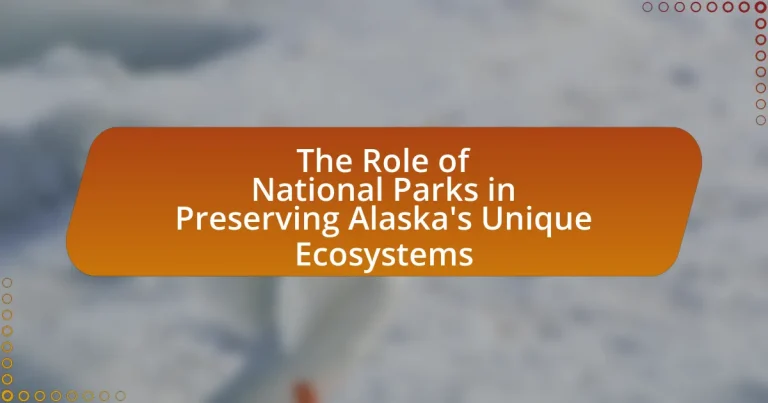National parks are essential for preserving Alaska’s unique ecosystems, safeguarding diverse habitats and species from human impact and climate change. Key parks such as Denali and Glacier Bay serve as critical sanctuaries for wildlife, including endangered species, while promoting biodiversity and ecological resilience. The article explores the specific ecosystems protected within these parks, the threats they face without such protections, and the role of national parks in cultural preservation and sustainable tourism. Additionally, it discusses management practices, funding challenges, and the importance of community engagement in conservation efforts, highlighting the multifaceted approach required to maintain Alaska’s natural heritage.
What is the role of national parks in preserving Alaska’s unique ecosystems?
National parks play a crucial role in preserving Alaska’s unique ecosystems by protecting diverse habitats and species from human impact and climate change. These parks, such as Denali National Park and Glacier Bay National Park, serve as sanctuaries for wildlife, including endangered species like the Steller sea lion and the polar bear, while also maintaining the integrity of ecosystems that are vital for biodiversity. The establishment of these protected areas helps to conserve critical natural resources, supports scientific research, and promotes ecological resilience, ensuring that Alaska’s unique environmental heritage is preserved for future generations.
How do national parks contribute to biodiversity in Alaska?
National parks in Alaska significantly contribute to biodiversity by protecting vast and varied ecosystems that support a wide range of plant and animal species. These parks encompass diverse habitats, including tundra, forests, wetlands, and coastal areas, which are home to over 1,700 species of vascular plants, 600 species of birds, and numerous mammals, including iconic species like the grizzly bear and moose. The preservation of these habitats within national parks helps maintain genetic diversity and ecological resilience, allowing species to adapt to environmental changes. For instance, Denali National Park protects critical habitats for caribou and Dall sheep, ensuring their populations remain stable. Additionally, national parks serve as vital research sites, providing scientists with opportunities to study ecosystems and monitor changes due to climate change, thereby enhancing our understanding of biodiversity conservation.
What specific ecosystems are protected within Alaska’s national parks?
Alaska’s national parks protect diverse ecosystems, including coastal, tundra, boreal forest, and alpine ecosystems. For instance, Kenai Fjords National Park safeguards marine ecosystems and glacial landscapes, while Denali National Park encompasses subarctic tundra and mountainous terrains. These parks serve as critical habitats for numerous species, including caribou, grizzly bears, and migratory birds, thereby maintaining biodiversity and ecological balance.
How do these ecosystems support various species in Alaska?
Alaska’s ecosystems support various species through diverse habitats that provide essential resources such as food, shelter, and breeding grounds. The rich biodiversity found in national parks, including Denali and Glacier Bay, creates a complex web of interactions among species, from large mammals like moose and bears to numerous bird species and marine life. For instance, the coastal ecosystems of Glacier Bay are crucial for salmon, which rely on the nutrient-rich waters for spawning, while the tundra habitats in Denali support caribou migrations and provide foraging opportunities. These ecosystems are protected by national parks, ensuring the preservation of these critical habitats and the species that depend on them.
Why are national parks essential for conservation efforts in Alaska?
National parks are essential for conservation efforts in Alaska because they protect vast and diverse ecosystems that are critical for biodiversity. These parks encompass approximately 54 million acres of pristine wilderness, safeguarding habitats for numerous species, including endangered ones like the Steller’s eider and the polar bear. The establishment of national parks helps to mitigate the impacts of climate change by preserving natural landscapes that act as carbon sinks. Furthermore, they provide a controlled environment for scientific research, enabling the study of ecological processes and the effects of environmental changes. This combination of habitat protection, climate resilience, and research opportunities underscores the vital role national parks play in conserving Alaska’s unique ecosystems.
What threats do Alaska’s ecosystems face without national park protections?
Alaska’s ecosystems face significant threats without national park protections, including habitat destruction, climate change impacts, and increased human activity. Habitat destruction arises from industrial development, such as oil drilling and mining, which can lead to loss of biodiversity and disruption of wildlife corridors. Climate change exacerbates these threats by altering temperature and precipitation patterns, affecting species migration and survival. Additionally, without national park protections, human activities like tourism and resource extraction can increase, leading to pollution and further habitat degradation. Studies indicate that protected areas are crucial for maintaining ecological integrity, as they help preserve critical habitats and mitigate the effects of climate change on vulnerable species.
How do national parks help mitigate climate change impacts in Alaska?
National parks in Alaska help mitigate climate change impacts by preserving critical habitats and ecosystems that sequester carbon. These parks protect vast areas of wilderness, including forests, wetlands, and tundra, which play a significant role in absorbing carbon dioxide from the atmosphere. For instance, the boreal forests in Alaska are known to store substantial amounts of carbon in their biomass and soil. Additionally, national parks serve as research sites for climate change studies, providing valuable data that can inform conservation strategies. By maintaining biodiversity and ecosystem health, these parks enhance resilience against climate change effects, such as increased temperatures and altered precipitation patterns.
What role do national parks play in cultural preservation in Alaska?
National parks in Alaska play a crucial role in cultural preservation by protecting Indigenous heritage sites and traditional practices. These parks serve as custodians of archaeological sites, historical landmarks, and cultural landscapes that are significant to Alaska Native communities. For instance, parks like Katmai and Wrangell-St. Elias safeguard ancient village sites and burial grounds, ensuring that the cultural narratives and histories of Indigenous peoples are maintained. Additionally, national parks facilitate the continuation of traditional subsistence practices, which are vital for the cultural identity and survival of these communities. By providing a framework for cultural education and interpretation, national parks help raise awareness about the rich cultural heritage of Alaska, fostering respect and understanding among visitors and locals alike.
How do national parks protect indigenous cultures and traditions?
National parks protect indigenous cultures and traditions by preserving sacred sites, traditional lands, and cultural practices. For instance, in Alaska, national parks like Denali and Wrangell-St. Elias safeguard areas that are integral to the cultural heritage of Native Alaskan tribes, allowing them to maintain their traditional lifestyles and practices. Additionally, these parks often involve indigenous communities in management decisions, ensuring that their knowledge and cultural values are respected and integrated into conservation efforts. This collaborative approach not only protects the physical landscape but also fosters the continuation of indigenous traditions and languages, which are vital to their cultural identity.
What historical significance do national parks hold for Alaska’s communities?
National parks in Alaska hold significant historical importance for local communities as they serve as sites of cultural heritage, traditional subsistence practices, and historical events. For instance, Denali National Park is not only a natural wonder but also a place where Indigenous peoples have lived for thousands of years, relying on its resources for sustenance and cultural practices. Additionally, national parks have played a role in the preservation of historical sites, such as the remnants of early 20th-century mining operations in Wrangell-St. Elias National Park, which reflect the region’s economic history. These parks also foster community identity and pride, as they are often central to local narratives and tourism, contributing to the economic and social fabric of Alaska’s communities.
How do national parks in Alaska promote sustainable tourism?
National parks in Alaska promote sustainable tourism by implementing strict regulations that protect natural resources while providing educational opportunities for visitors. These parks, such as Denali National Park and Preserve, limit the number of visitors and control access to sensitive areas, which helps minimize environmental impact. Additionally, they offer programs that educate tourists about local ecosystems, wildlife conservation, and the importance of preserving natural habitats. For instance, the National Park Service emphasizes Leave No Trace principles, encouraging visitors to reduce their footprint and respect wildlife. This approach not only conserves Alaska’s unique ecosystems but also fosters a culture of responsible tourism among visitors.
What educational opportunities do national parks provide regarding Alaska’s ecosystems?
National parks in Alaska provide educational opportunities through interpretive programs, guided tours, and visitor centers that focus on the state’s unique ecosystems. These programs often include hands-on activities, workshops, and ranger-led talks that educate visitors about the diverse flora and fauna, geological features, and ecological processes specific to Alaska. For instance, Denali National Park offers educational resources that highlight the park’s wildlife, such as grizzly bears and caribou, and the importance of preserving their habitats. Additionally, the National Park Service collaborates with local schools and organizations to promote environmental education, fostering a deeper understanding of conservation efforts and the significance of Alaska’s natural resources.
What are the specific management practices used in Alaska’s national parks?
Alaska’s national parks employ specific management practices that include resource protection, visitor management, and habitat restoration. Resource protection focuses on conserving wildlife and natural resources through regulations and monitoring, ensuring that ecosystems remain intact. Visitor management involves implementing strategies to minimize human impact, such as designated trails and educational programs to promote responsible behavior. Habitat restoration efforts aim to rehabilitate degraded areas, often through native plant reintroduction and invasive species control. These practices are essential for maintaining the ecological integrity of Alaska’s unique ecosystems, as evidenced by the successful recovery of certain species and habitats within the parks.
How do park management strategies enhance ecosystem preservation?
Park management strategies enhance ecosystem preservation by implementing practices that protect biodiversity, maintain natural habitats, and regulate human activities. These strategies include establishing protected areas, conducting ecological monitoring, and enforcing regulations to minimize human impact. For instance, the National Park Service employs zoning to limit development and recreational activities in sensitive areas, which helps to preserve critical habitats for species such as the endangered Steller’s eider. Additionally, park management often involves restoration projects that rehabilitate degraded ecosystems, thereby improving overall ecological health. Research indicates that well-managed parks can significantly increase species richness and ecosystem resilience, demonstrating the effectiveness of these strategies in preserving unique ecosystems, particularly in regions like Alaska.
What role does research play in the management of these parks?
Research plays a critical role in the management of national parks by providing data-driven insights that inform conservation strategies and policy decisions. For instance, studies on wildlife populations, such as the monitoring of caribou migration patterns, help park managers implement effective protection measures. Additionally, research on climate change impacts, like the melting of glaciers in Alaska, guides adaptive management practices to preserve ecosystems. The National Park Service collaborates with scientists and researchers to ensure that management decisions are based on the latest scientific findings, thereby enhancing the effectiveness of conservation efforts.
How are invasive species managed within Alaska’s national parks?
Invasive species within Alaska’s national parks are managed through a combination of prevention, early detection, and control measures. The National Park Service implements strategies such as monitoring ecosystems for invasive species, conducting public education campaigns to raise awareness, and employing mechanical, chemical, and biological control methods to eradicate or contain invasive populations. For instance, the management plan for Denali National Park includes regular surveys and removal efforts for invasive plants like yellow toadflax and common dandelion, which threaten native flora. These actions are supported by research indicating that proactive management is essential for preserving the integrity of Alaska’s unique ecosystems.
What partnerships exist to support the management of Alaska’s national parks?
Partnerships that support the management of Alaska’s national parks include collaborations with local Native corporations, non-profit organizations, and federal agencies. These partnerships enhance resource management, conservation efforts, and community engagement. For instance, the National Park Service collaborates with organizations like the Alaska Conservation Foundation and the Alaska Wilderness League to promote sustainable practices and protect wildlife habitats. Additionally, partnerships with local tribes, such as the Alaska Native Tribal Health Consortium, help integrate traditional ecological knowledge into park management strategies, ensuring that cultural values are respected and preserved.
How do local communities engage with national park management?
Local communities engage with national park management through collaborative partnerships, participation in decision-making processes, and involvement in conservation initiatives. These communities often provide valuable local knowledge that informs park management strategies, ensuring that ecological preservation aligns with cultural and economic needs. For instance, in Alaska, Indigenous groups actively participate in co-management agreements, which allow them to influence policies that affect their ancestral lands and resources. This engagement is supported by the National Park Service, which recognizes the importance of local input in maintaining the ecological integrity of national parks while respecting cultural heritage.
What role do non-profit organizations play in supporting national parks?
Non-profit organizations play a crucial role in supporting national parks by providing funding, advocacy, and volunteer services that enhance park management and conservation efforts. These organizations often raise significant financial resources through donations and grants, which are essential for park maintenance, educational programs, and ecological restoration projects. For instance, the National Park Foundation, the official charity of the National Park Service, has contributed over $500 million to support various initiatives across national parks, including those in Alaska. Additionally, non-profits engage in advocacy to influence policy decisions that affect park funding and protection, ensuring that the unique ecosystems of places like Alaska are preserved for future generations.

What challenges do national parks in Alaska face in ecosystem preservation?
National parks in Alaska face significant challenges in ecosystem preservation, primarily due to climate change, invasive species, and resource extraction. Climate change leads to rising temperatures and altered precipitation patterns, which disrupt native habitats and species. For instance, the National Park Service reports that Alaska’s average temperature has increased by 3°F since the 1970s, affecting glacial ecosystems and wildlife migration patterns. Invasive species, introduced through human activity, threaten native flora and fauna by outcompeting them for resources. Additionally, resource extraction activities, such as mining and oil drilling, pose risks to the ecological integrity of these protected areas, as they can lead to habitat destruction and pollution. These factors collectively hinder the ability of national parks in Alaska to maintain their unique ecosystems.
How does climate change impact Alaska’s national parks?
Climate change significantly impacts Alaska’s national parks by altering ecosystems, increasing temperatures, and affecting wildlife habitats. For instance, rising temperatures have led to the melting of glaciers in parks like Denali National Park, which affects water availability and alters the landscape. Additionally, changing precipitation patterns can lead to increased flooding or drought, disrupting the delicate balance of these ecosystems. The National Park Service reports that permafrost thawing is causing ground instability, which can damage park infrastructure and affect plant and animal species that rely on stable ground conditions. These changes threaten biodiversity and the overall health of the ecosystems within Alaska’s national parks.
What specific changes are observed in Alaska’s ecosystems due to climate change?
Alaska’s ecosystems are experiencing significant changes due to climate change, including rising temperatures, altered precipitation patterns, and shifting species distributions. Specifically, average temperatures in Alaska have increased by approximately 3°F (1.6°C) since the 1970s, leading to the melting of glaciers and permafrost. This thawing permafrost releases greenhouse gases, further exacerbating climate change. Additionally, warmer temperatures have resulted in the northward migration of species such as the moose and the spruce bark beetle, which has devastated vast areas of forest. These changes disrupt food webs and habitat availability, impacting both wildlife and indigenous communities reliant on these ecosystems.
How are national parks adapting to these changes?
National parks are adapting to changes by implementing strategies such as habitat restoration, wildlife management, and climate change monitoring. For instance, in Alaska, national parks are actively restoring native plant species to combat the effects of invasive species and changing climate conditions. Additionally, park management is utilizing data from climate monitoring programs to adjust conservation practices, ensuring that wildlife corridors remain viable as animal migration patterns shift due to temperature changes. These adaptive measures are supported by research from the National Park Service, which emphasizes the importance of resilience in ecosystem management to maintain biodiversity and ecological integrity in the face of environmental changes.
What funding and resource challenges do national parks encounter?
National parks encounter significant funding and resource challenges that hinder their operational effectiveness and conservation efforts. The National Park Service has reported a backlog of maintenance projects exceeding $11 billion, which reflects the insufficient funding allocated for upkeep and infrastructure improvements. Additionally, fluctuating federal budgets and reliance on discretionary funding create instability, making it difficult for parks to plan long-term conservation strategies. These financial constraints often lead to reduced staffing levels, limiting the ability to manage ecosystems effectively and respond to environmental threats such as climate change and invasive species.
How do budget constraints affect conservation efforts in Alaska’s national parks?
Budget constraints significantly hinder conservation efforts in Alaska’s national parks by limiting funding for essential programs and initiatives. These financial limitations result in reduced staffing, which affects the ability to monitor wildlife populations and manage invasive species effectively. For instance, the National Park Service reported that budget cuts have led to a decrease in the number of rangers available for fieldwork, directly impacting conservation activities. Additionally, insufficient funds restrict the implementation of critical maintenance projects, such as repairing trails and facilities, which are vital for both ecosystem health and visitor safety. Consequently, these constraints compromise the overall effectiveness of conservation strategies aimed at preserving Alaska’s unique ecosystems.
What strategies are being implemented to secure funding for these parks?
Strategies being implemented to secure funding for Alaska’s national parks include public-private partnerships, grant applications, and community fundraising initiatives. Public-private partnerships leverage resources and expertise from both sectors to enhance park management and funding. Grant applications target federal and state funding opportunities, as well as private foundations dedicated to conservation. Community fundraising initiatives engage local residents and organizations, fostering a sense of ownership and support for the parks, which can lead to increased financial contributions. These strategies collectively aim to ensure sustainable funding for the preservation of Alaska’s unique ecosystems.
What can visitors do to support the preservation of Alaska’s national parks?
Visitors can support the preservation of Alaska’s national parks by following Leave No Trace principles, which include minimizing their impact on the environment. This involves staying on designated trails to protect native vegetation, properly disposing of waste to prevent pollution, and respecting wildlife by observing from a distance. According to the National Park Service, these practices help maintain the integrity of ecosystems and ensure that natural resources remain undisturbed for future generations. Additionally, visitors can participate in park volunteer programs, which contribute directly to conservation efforts and habitat restoration projects.


